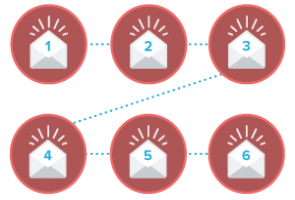If you read the title of this post and thought, “Wait, there are different kinds of email sequences?” this message is for you.
Today, I want to show you how you can get the most mileage out of your email campaigns, and that is accomplished in two ways. First, you have to know the people in your audience and the kind of content that clicks with them. Next, you have to know how to deliver the message. This is where various email styles come into play.
Now, I will make this one disclaimer before I continue: The title of the article is really a rhetorical question. If you’re reading this expecting to be spoon-fed a be-all, end-all solution to your email marketing woes, you’re probably in the wrong place. My job is to show you some effective options and let you decide which way is going to work best.
With that in mind, here are a few ideas that I hope will get you thinking about your audience and how you can better connect with the people in it via email sequences. I emphasize sequences here because while one-shots can be effective one time, a sequence can keep people on the hook indefinitely. They allow you to build one concept or story onto another and keep the momentum up for as long as you want. It’s the best option, and it is one that I firmly believe in.
1. Straight-up Informational Content
Some businesses attract an audience that is all about the facts. In these instances, you want to gravitate away from sensationalism and simply educate the reader. These emails are typically short and lead to a landing page that provides information that is more comprehensive.
The trick here is to provide just enough information to pique interest in clicking through. You can create sequences that each highlight a key point. This broadens the appeal of the message and will attract larger segments of your list (provided you’re writing good subject lines). You can then analyze your open rates and push more specific sequences to specific list segments.
2. Newsletters
For the “enquiring minds” on your list, newsletters are a great way to connect with your audience. I consider newsletters sequences because the term implies an ongoing series of messages. These emails are also traditionally longer and need to maximize the use of good headlines to appeal to the broadest segment possible.
Since newsletters typically only drop an average of once or twice a month, you need to keep the content engaging so people anticipate hearing from you again. If your open rates for email newsletters have been slipping lately, it might be time to start split testing subject lines and figure out a better way to communicate with your target audience.
3. Single-Voice
Single-voice emails are those written from the perspective of one identified person or entity. Many marketers simply create a persona that represents the brand and writes as that persona.
The trap that too many marketers fall into here is that they tend to present an alarming amount of fictitious content as fact. Let me make this perfectly clear: Don’t do that. You might make a little money pulling people’s heartstrings, but when they find out that you’re full of bull, there goes any hope you have of re-establishing trust. Keep it real. That is all.
Also, be careful not to fall into the trap of repeating the same message over and over and over again. It’s an easy way to lose readers. Your emails should establish you as an authority in your niche, and an authority really should not run out of things to say.
4. Time-Sensitive Promotions
These work well for product launches and similar marketing initiatives. They make an attractive offer and then put a time limit on it. If you’ve never looked into the 4-Day Cash Machine email model, I highly recommend learning about it. A good copywriter or copywriting company should know what this is when you approach them, and a good writer should be able to put a relevant spin on the formula that suits your audience.
Some promo emails come on like Gangbusters while others take a more subtle approach. Which way you choose has everything to do with who your audience is and what it is already used to hearing from you. Don’t change gears in your emails – that’s a great way to alienate huge segments of your list.
5. The Storyline Approach
I’ve saved the best for last.
There is no easier way to keep an email sequence going than with a running story. Tell your brand story in narrative form. Yes, you can harness the power of fiction here, but you need to be able to relate the narrative back to testable, provable, tangible data that corroborate the message. Otherwise, you’re walking right into the same trap as you would be in Single-Voice mode.
Want to learn how to do this right? One of my writers who makes a huge majority of his money writing marketing emails swears by the power of Andre Chaperon’s AutoResponder Madness. Learn how to use this particular storytelling method in your emails (or find a seasoned writer who understands it well) and marvel as your open rates skyrocket, along with your conversions. There are, of course, similar methods out there, and you may find one that jibes with your approach a little better, but I say check this one out first.
Final takeaway: Yes, there are other methods and approaches, but the ones above are well worth some attention. You may decide after getting a taste of how each one works that you want to try a few variations on the theme. I say go for it. You know your audience better than anyone, so always make smart choices with how you approach the people in it.
